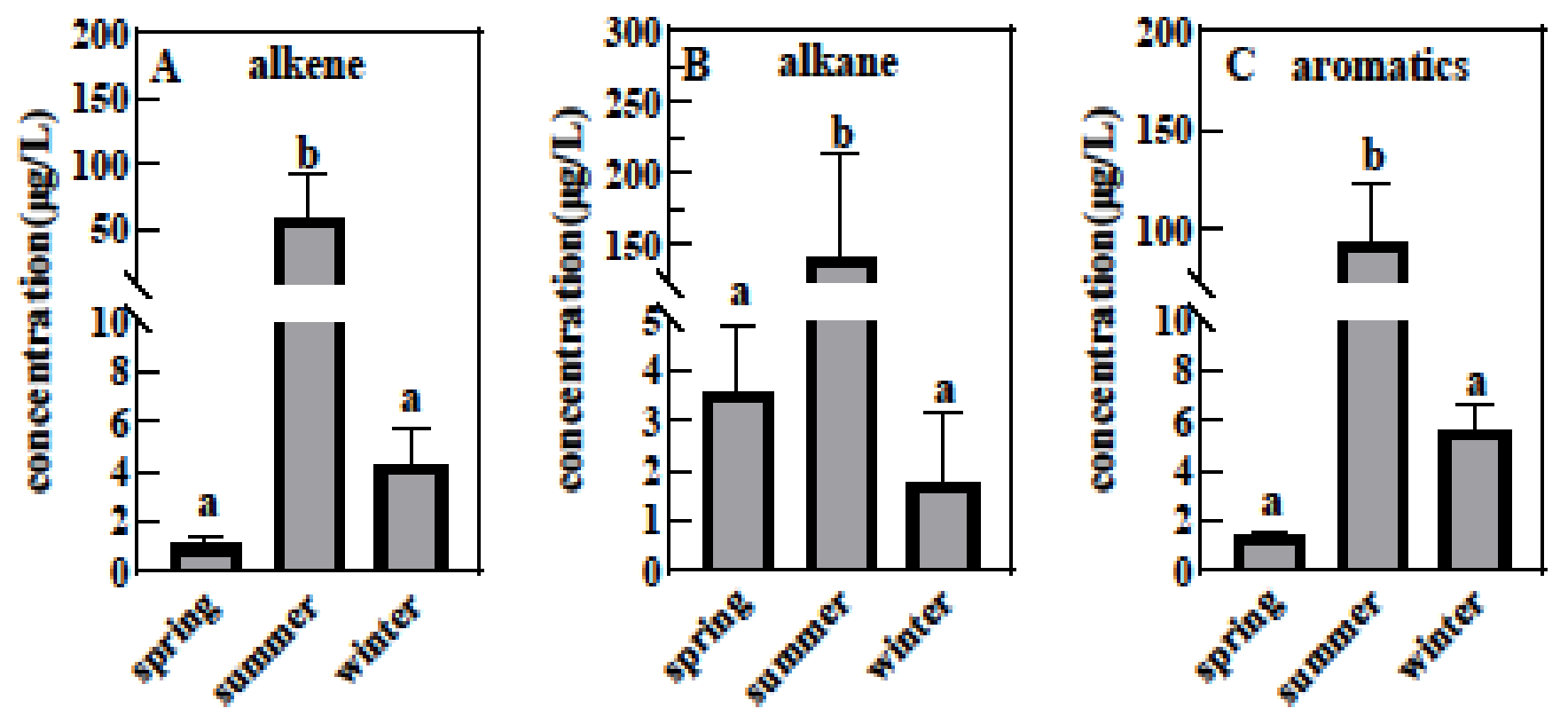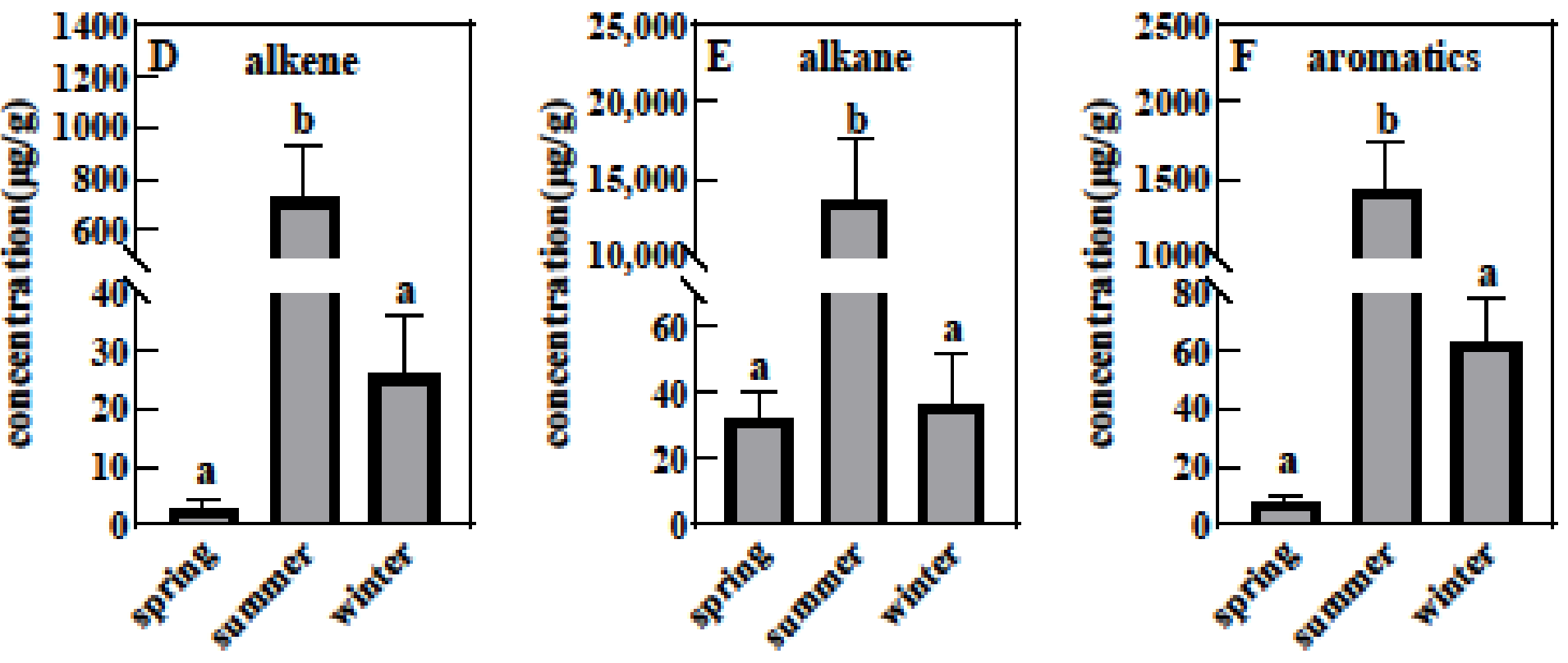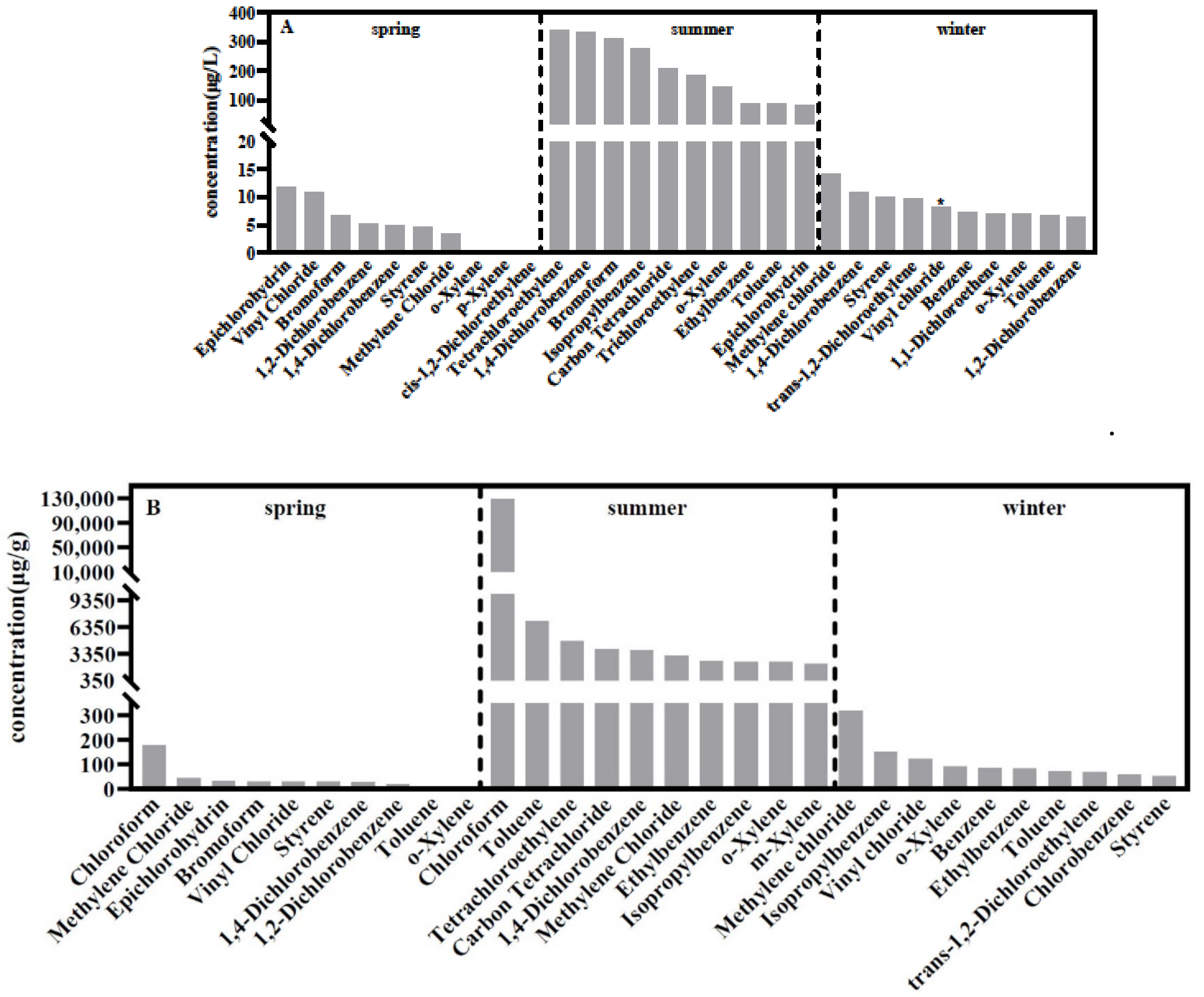Human Activities Aggravate VOC Pollution in the Huangshui River of the Tibetan Plateau
Abstract
:1. Introduction
2. Materials and Methods
2.1. Sampling Sites
2.2. Sample Processing
2.3. Statistical Analysis
3. Results and Discussion
3.1. Comparisons of VOCs
3.2. Influence of Seasons on the VOCs in Different Samples
3.3. Analysis of the Main VOCs in Different Seasons
3.4. Impact of Environmental Factors on VOCs
4. Conclusions
Supplementary Materials
Author Contributions
Funding
Institutional Review Board Statement
Informed Consent Statement
Data Availability Statement
Conflicts of Interest
References
- Frank, D.; Poole, S.; Kirchhoff, S.; Forde, C. Investigation of Sensory and Volatile Characteristics of Farmed and Wild Barramundi (Lates calcarifer) using Gas Chromatography-Olfactometry Mass Spectrometry and Descriptive Sensory Analysis. J. Agric. Food Chem. 2009, 21, 10302–10312. [Google Scholar] [CrossRef] [PubMed]
- Olsen, B.K.; Chislock, M.F.; Wilson, A.E. Eutrophication mediates a common off-flavor compound, 2-methylisoborneol, in a drinking water reservoir. Water Res. 2016, 92, 228–234. [Google Scholar] [CrossRef] [PubMed]
- Webber, M.A.; Atherton, P.; Newcombe, G. Taste and odour and public perceptions: What do our customers really think about their drinking water? J. Water Supply Res. Technol.-Aqua 2015, 64, 802–811. [Google Scholar] [CrossRef]
- Rao, P.; Annable, M.D.; Kim, H. NAPL source zone characterization and remediation technology performance assessment: Recent developments and applications of tracer techniques. J. Contam. Hydrol. 2000, 45, 63–78. [Google Scholar] [CrossRef]
- Yamamoto, K. Occurrence, distribution, and trends of volatile organic compounds in urban rivers and their estuaries in Osaka, Japan, 1993–2006. Bull. Environ. Contam. Toxicol. 2014, 92, 472–477. [Google Scholar] [CrossRef] [PubMed]
- Li, C.; Li, Q.; Tong, D.; Wang, Q.; Wu, M.; Sun, B.; Su, G.; Tan, L. Environmental impact and health risk assessment of volatile organic compound emissions during different seasons in Beijing. J. Environ. Sci. 2019, 93, 1–12. [Google Scholar] [CrossRef]
- Deng, X.; Chen, J.; Hansson, L.A.; Zhao, X.; Xie, P. Eco-chemical mechanisms govern phytoplankton emissions of dimethylsulfide in global surface waters. Natl. Sci. Rev. 2021, 8, nwaa140. [Google Scholar] [CrossRef]
- Liu, C.; Xu, Z.; Du, Y.; Guo, H. Analyses of volatile organic compounds concentrations and variation trends in the air of Changchun, the northeast of China. Atmos. Environ. 2000, 34, 4459–4466. [Google Scholar] [CrossRef]
- Liu, M.; Wu, T.; Zhao, X.; Zan, F.; Yang, G.; Miao, Y. Cyanobacteria blooms potentially enhance volatile organic compound (VOC) emissions from a eutrophic lake: Field and experimental evidence. Environ. Res. 2021, 202, 111664. [Google Scholar] [CrossRef] [PubMed]
- Solomon, G.M.; Hurley, S.; Carpenter, C.; Young, T.M.; English, P.; Reynolds, P. Fire and Water: Assessing Drinking Water Contamination After a Major Wildfire. ACS EST Water 2021, 1, 1878–1886. [Google Scholar] [CrossRef] [PubMed]
- Yang, C.; Gao, P.; Hou, F.; Yan, T.; Chang, S.; Chen, X.; Wang, Z. Relationship between chemical composition of native forage and nutrient digestibility by Tibetan sheep on the Qinghai-Tibetan Plateau. J. Anim. Sci. 2018, 96, 1140–1149. [Google Scholar] [CrossRef] [PubMed]
- Cheng, Y.X.; Gao, Q.S.; Li, J.; Li, H.; Jiao, L.X. Characteristics of Volatile Organic Compounds Pollution and Risk Assessment of Nansi Lake in Huaihe River Basin. Huan Jing Ke Xue 2021, 42, 1820–1829. [Google Scholar] [PubMed]
- Zeng, S.; Liu, H.; Liu, Z.; Kaufmann, G.; Zeng, Q.; Chen, B. Seasonal and diurnal variations in DIC, NO3-and TOC concentrations in spring-pond ecosystems under different land-uses at the Shawan Karst Test Site, SW China: Carbon limitation of aquatic photosynthesis. J. Hydrol. 2019, 574, 811–821. [Google Scholar] [CrossRef]
- Kuang, Y.; Guo, X.; Hu, J.; Li, S.; Zhang, R.; Gao, Q.; Yang, X.; Chen, Q.; Sun, W. Occurrence and risks of antibiotics in an urban river in northeastern Tibetan Plateau. Sci. Rep. 2020, 10, 20054. [Google Scholar] [CrossRef] [PubMed]
- Liu, B.; Chen, L.; Huang, L.; Wang, Y.; Li, Y. Distribution of volatile organic compounds (VOCs) in surface water, soil, and groundwater within a chemical industry park in Eastern China. Water Sci. Technol. 2015, 71, 259–267. [Google Scholar] [CrossRef] [PubMed]
- Parlin, A.A.; Kondo, M.; Watanabe, N.; Nakamura, K.; Yamada, M.; Wang, J.; Komai, T. Water-Enhanced Flux Changes under Dynamic Temperatures in the Vertical Vapor-Phase Diffusive Transport of Volatile Organic Compounds in Near-Surface Soil Environments. Sustainability 2021, 13, 6570. [Google Scholar] [CrossRef]
- Niu, Z.; Kong, S.; Zheng, H.; Yang, Q.; Liu, J.; Feng, Y.; Wu, J.; Zheng, S.; Zeng, X.; Yao, L.; et al. Temperature dependence of source profiles for volatile organic compounds from typical volatile emission sources. Sci. Total Environ. 2021, 751, 141741. [Google Scholar] [CrossRef] [PubMed]
- Zuo, Z.; Yang, Y.; Xu, Q.; Yang, W.; Zhao, J.; Zhou, L. Effects of phosphorus sources on volatile organic compound emissions from Microcystis flos-aquae and their toxic effects on Chlamydomonas reinhardtii. Environ. Geochem. Health 2018, 40, 1283–1298. [Google Scholar] [CrossRef]
- Weisskopf, L.; Schulz, S.; Garbeva, P. Microbial volatile organic compounds in intra-kingdom and inter-kingdom interactions. Nat. Rev. Microbiol. 2021, 19, 391–404. [Google Scholar] [CrossRef]
- Li, S.; Shi, P. Tourism Distribution of Xining city Tourism Circle Evolution and spatial characteristics. In Proceedings of the 2017 6th International Conference on Energy and Environmental Protection (ICEEP 2017), Zhuhai, China, 29–30 June 2017; Volume 143, pp. 272–279. [Google Scholar]
- Chen, L.; Wei, Q.; Xu, G.; Wei, M.; Chen, H. Contamination and Ecological Risk Assessment of Heavy Metals in Surface Sediments of Huangshui River, Northwest China. J. Chem. 2022, 2022, 4282992. [Google Scholar] [CrossRef]
- Zhang, L.; Tan, X.; Chen, H.; Liu, Y.; Cui, Z. Effects of Agriculture and Animal Husbandry on Heavy Metal Contamination in the Aquatic Environment and Human Health in Huangshui River Basin. Water 2022, 14, 549. [Google Scholar] [CrossRef]
- Yang, J.; Wang, K.; Zhao, Q.; Huang, l.; Yuan, C.; Chen, W.; Yang, W. Underestimated public health risks caused by overestimated VOC removal in wastewater treatment processes. Environ. Sci. Process. Impacts 2014, 16, 271–279. [Google Scholar] [CrossRef] [PubMed]
- Liu, L.; Zhou, H. Investigation and assessment of volatile organic compounds in water sources in China. Environ. Monit. Assess. 2011, 173, 825–836. [Google Scholar] [CrossRef] [PubMed]
- Palanisamy, K.; Mezgebe, B.; Sorial, G.; Sahle-Demessie, E. Biofiltration of Chloroform in a Trickle Bed Air Biofilter Under Acidic Conditions. Water Air Soil Pollut. 2016, 227, 478. [Google Scholar] [CrossRef]
- Wei, H.; Lu, C.; Liu, Y. Farmland Changes and Their Ecological Impact in the Huangshui River Basin. Land 2021, 10, 1082. [Google Scholar] [CrossRef]
- Zhou, S.; Lin, G.; Lin, Q.; Su, S.; Cheng, M. Pollution of Microplastics in Coastal Plain of the Huangshui River Basin. In IOP Conference Series: Earth and Environmental Science; IOP Publishing: Bristol, UK, 2020; Volume 546, p. 032040. [Google Scholar]
- Xiang, Z. Analysis of Water Pollution and Calculation of Ecological Compensation Standards in Huangshui River Basin Based on Ecological Footprint. In Journal of Physics: Conference Series; IOP Publishing: Bristol, UK, 2020; Volume 1533, p. 022070. [Google Scholar]
- Dai, H.; Jing, S.; Wang, H.; Ma, Y.; Li, L.; Song, W.; Kan, H. VOC characteristics and inhalation health risks in newly renovated residences in Shanghai, China. Sci. Total Environ. 2016, 577, 73–83. [Google Scholar] [CrossRef]
- Tong, L.; Liao, X.; Chen, J.; Xiao, H.; Xu, L.; Zhang, F.; Niu, Z.; Yu, J. Pollution characteristics of ambient volatile organic compounds (VOCs) in the southeast coastal cities of China. Environ. Sci. Pollut. Res. 2013, 20, 2603–2615. [Google Scholar] [CrossRef]
- Jamali, M.R.; Firouzjah, A.; Rahnama, R. Solvent-assisted dispersive solid phase extraction. Talanta 2013, 116, 454–459. [Google Scholar] [CrossRef] [PubMed]
- Komilis, D.P.; Ham, R.K.; Park, J.K. Emission of volatile organic compounds during composting of municipal solid wastes. Water Res. 2004, 38, 1707–1714. [Google Scholar] [CrossRef] [PubMed]
- Mendes, M.; Cunha, D.; dos Santos, v.l.; Vianna, M.T.; Marques, M. Ecological risk assessment (ERA) based on contaminated groundwater to predict potential impacts to a wetland ecosystem. Environ. Sci. Pollut. Res. 2020, 27, 26332–26349. [Google Scholar] [CrossRef] [PubMed]
- Jin, S.; Fallgren, P.H.; Bilgin, A.A.; Morris, J.M.; Barnes, P.W. Bioremediation of benzene, ethylbenzene, and xylenes in groundwater under iron-amended, sulfate-reducing conditions. Environ. Toxicol. Chem. 2007, 26, 249–253. [Google Scholar] [CrossRef] [PubMed]
- Kawabe, Y.; Komai, T. A Case Study of Natural Attenuation of Chlorinated Solvents Under Unstable Groundwater Conditions in Takahata, Japan. Bull. Environ. Contam. Toxicol. 2019, 102, 280–286. [Google Scholar] [CrossRef] [PubMed]
- Kistemann, T.; Hundhausen, J.; Herbst, S.; Classen, T.; Farber, H. Assessment of a groundwater contamination with vinyl chloride (VC) and precursor volatile organic compounds (VOC) by use of a geographical information system (GIS). Int. J. Hyg. Environ. Health 2008, 211, 308–317. [Google Scholar] [CrossRef]
- Williams, P.; Benton, L.; Warmerdam, J.; Sheehan, P. Comparative Risk Analysis of Six Volatile Organic Compounds in California Drinking Water. Environ. Sci. Technol. 2002, 36, 4721–4728. [Google Scholar] [CrossRef] [PubMed]
- Lána, R.; Vavrova, M.; Navratil, S.; Brabencova, E.; Vecerk, V. Organochlorine Pollutants in Chub, Leuciscus cephalus, from the Svratka River, Czech Republic. Bull. Environ. Contam. Toxicol. 2010, 84, 726–730. [Google Scholar] [CrossRef]
- Yang, C.; Xiao, N.; Chang, Z.; Huang, J.; Zeng, W. Biodegradation of TOC by Nano-Fe2O3 Modified SMFC and Its Potential Environmental Effects. ChemistrySelect 2021, 6, 5597–5602. [Google Scholar] [CrossRef]
- Kamaruddin, M.A.; Hlid, N.; Yusoff, M.; Zainol, M.; Alrozi, R. TOC, TKN and C/N ratio fractionation of organic wastes under elevated temperature regime by using hydrothermal approach. In Proceedings of the 5th International Conference on Green Design and Manufacture (IConGDM 2019), Bandung, Indonesia, 29–30 April 2019; AIP Conference Proceedings: Melville, NY, USA, 2019. [Google Scholar]
- Forat Yasir, A. Removal of TOC from oily wastewater by electrocoagulation technology. In IOP Conference Series: Materials Science and Engineering; IOP Publishing: Bristol, UK, 2020; Volume 928, p. 022024. [Google Scholar]
- Gehan, M.; Mohamed, I.; Laila, A.; Mohamed, E. Critical geochemical insight into Alexandria coast with special reference to diagnostic ratios (TOC/TN & Sr/Ca and heavy metals ecotoxicological hazards. Egypt. J. Aquat. Res. 2020, 46, 27–33. [Google Scholar]
- Glauser, A.; Morf, L.S.; Weibel, G.; Eggenberger, U. Ten-years monitoring of MSWI bottom ashes with focus on TOC development and leaching behaviour. Waste Manag. 2020, 117, 104–113. [Google Scholar] [CrossRef]
- Hammouda, O.; Gaber, A.; Abdelraouf, N. Microalgae and wastewater treatment. Ecotox. Environ. Saf. 1995, 31, 205–210. [Google Scholar] [CrossRef]
- Johnson, H.M.; Stets, E.G. Nitrate in Streams during Winter Low-Flow Conditions as an Indicator of Legacy Nitrate. Water Resour. Res. 2020, 56, e2019WR026996. [Google Scholar] [CrossRef]
- Azevedo, S.M.; Carmichael, W.W.; Jochimsen, E.M.; Rinehart, K.L.; Lau, S.; Shaw, G.R.; Eaglesham, G.K. Human intoxication by microcystins during renal dialysis treatment in Caruaru-Brazil. Toxicology 2002, 181, 441–446. [Google Scholar] [CrossRef]
- Buzancic, M.; Gladan, Z.N.; Marasovic, I.; Kuspilic, G.; Grbec, B. Eutrophication influence on phytoplankton community composition in three bays on the eastern Adriatic coast. Oceanologia 2016, 58, 302–316. [Google Scholar] [CrossRef]
- Zuo, Z.; Yang, L.; Chen, S.; Ye, C.; Han, Y.; Wang, S.; Ma, Y. Effects of nitrogen nutrients on the volatile organic compound emissions from Microcystis aeruginosa. Ecotox. Environ. Saf. 2018, 216, 214–220. [Google Scholar] [CrossRef] [PubMed]
- Deng, X.; Ruan, L.; Ren, R.; Tao, M.; Zhang, J.; Wang, L.; Yan, Y.; Wen, X.; Yang, X.; Xie, P. Phosphorus accelerate the sulfur cycle by promoting the release of malodorous volatile organic sulfur compounds from Microcystis in freshwater lakes. Sci. Total Environ. 2022, 845, 157280. [Google Scholar] [CrossRef] [PubMed]
- Deng, X.; Qi, M.; Ren, R.; Liu, J.; Sun, X.; Xie, P.; Chen, J. The relationships between odors and environmental factors at bloom and non-bloom area in Lake Taihu, China. Chemosphere 2019, 218, 569–576. [Google Scholar]





| Seasons | Samples | Alkenes | Nonparametric Tests | Alkanes | Nonparametric Tests | Aromatics | Nonparametric Tests |
|---|---|---|---|---|---|---|---|
| spring | water | 1.01 ± 0.11 | p < 0.001 | 3.19 ± 0.24 | p < 0.001 | 1.31 ± 0.02 | p < 0.001 |
| sediment | 2.45 ± 0.15 | 31.23 ± 1.30 | 7.54 ± 0.31 | ||||
| summer | water | 62.66 ± 4.66 | p < 0.001 | 145.57 ± 9.47 | p < 0.001 | 89.22 ± 4.30 | p < 0.001 |
| sediment | 648.50 ± 42.34 | 13,052.27 ± 66.69 | 1372.73 ± 52.24 | ||||
| winter | water | 3.67 ± 0.20 | p < 0.001 | 2.05 ± 0.22 | p < 0.001 | 5.36 ± 0.14 | p < 0.001 |
| sediment | 23.96 ± 4.01 | 28.37 ± 2.78 | 60.46 ± 3.48 |
Publisher’s Note: MDPI stays neutral with regard to jurisdictional claims in published maps and institutional affiliations. |
© 2022 by the authors. Licensee MDPI, Basel, Switzerland. This article is an open access article distributed under the terms and conditions of the Creative Commons Attribution (CC BY) license (https://creativecommons.org/licenses/by/4.0/).
Share and Cite
Yang, X.; Deng, X.; Li, G.; Liu, Y.; Gao, Q. Human Activities Aggravate VOC Pollution in the Huangshui River of the Tibetan Plateau. Sustainability 2022, 14, 11983. https://doi.org/10.3390/su141911983
Yang X, Deng X, Li G, Liu Y, Gao Q. Human Activities Aggravate VOC Pollution in the Huangshui River of the Tibetan Plateau. Sustainability. 2022; 14(19):11983. https://doi.org/10.3390/su141911983
Chicago/Turabian StyleYang, Xi, Xuwei Deng, Guangxin Li, Yu Liu, and Qiang Gao. 2022. "Human Activities Aggravate VOC Pollution in the Huangshui River of the Tibetan Plateau" Sustainability 14, no. 19: 11983. https://doi.org/10.3390/su141911983
APA StyleYang, X., Deng, X., Li, G., Liu, Y., & Gao, Q. (2022). Human Activities Aggravate VOC Pollution in the Huangshui River of the Tibetan Plateau. Sustainability, 14(19), 11983. https://doi.org/10.3390/su141911983






